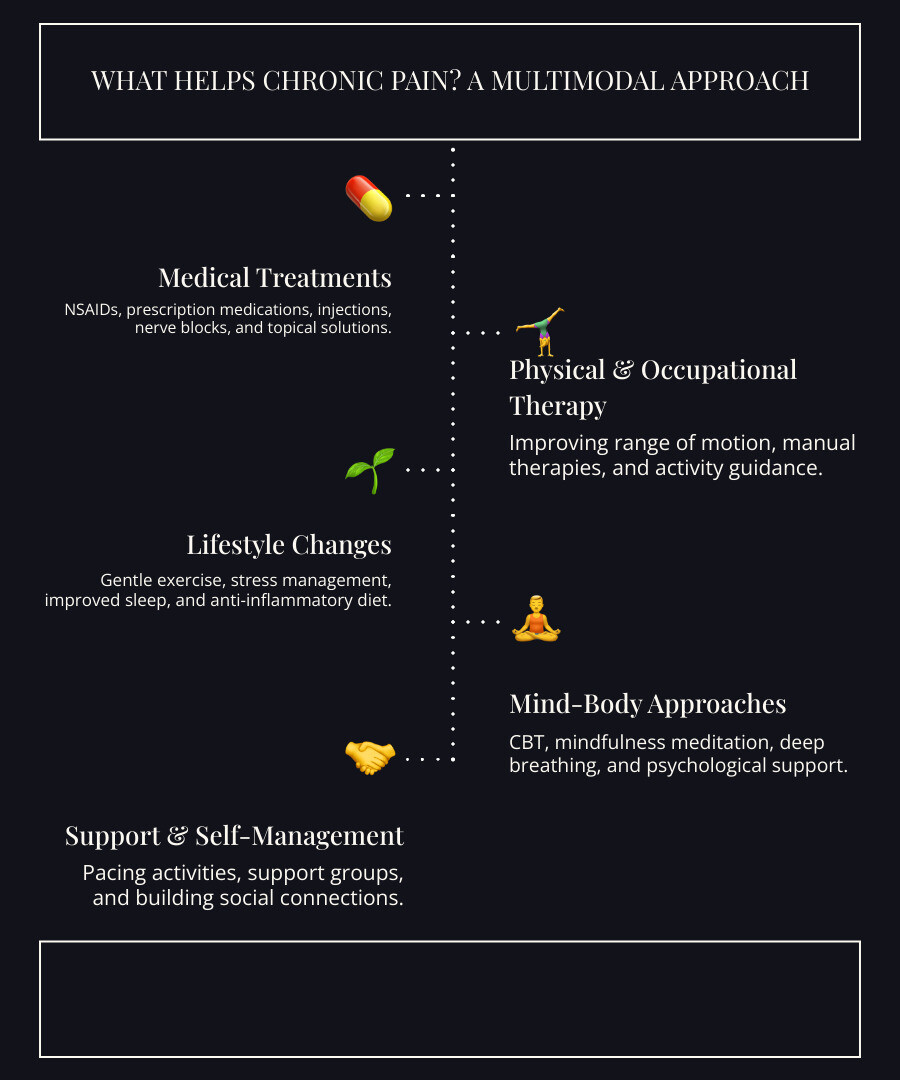Understanding Chronic Pain: More Than Just an Ache
What helps chronic pain? The answer lies in a comprehensive approach combining medical treatments, lifestyle changes, and mind-body therapies. Chronic pain, defined as pain lasting longer than three months, affects over 51 million Americans—that's 1 in 5 adults. Unlike acute pain, which is a temporary warning signal, chronic pain persists long after an injury has healed. The World Health Organization now recognizes it as a disease, not just a symptom.
This persistent pain can change how your nervous system works through a process called central sensitization. Your nerves become hypersensitive, sending constant pain signals even without a clear cause. This creates a vicious cycle known as the "terrible triad," where pain leads to sleep problems and depression, which in turn worsens the pain.
| Feature | Acute Pain | Chronic Pain |
|---|---|---|
| Duration | Less than 3 months | More than 3 months |
| Purpose | Warning signal of injury or illness | Often serves no protective purpose |
| Treatment | Focus on healing the underlying cause | Focus on management, function, and quality of life |
Modern pain science shows that chronic pain is manageable. While a cure isn't always possible, the right strategies can significantly reduce pain and improve your quality of life. I'm Tony Enrico, and through my work developing targeted topical formulations like Neuropasil, I've seen that effective management combines the right products with comprehensive lifestyle changes.

Common Causes and Risk Factors
Chronic pain can stem from various sources, often a combination of factors:
- Underlying Conditions: The Ultimate Guide to Osteoarthritis, fibromyalgia, and nerve damage from conditions like Peripheral Neuropathy Symptoms or Sciatic Nerve Pain are common culprits.
- Past Injuries: Pain can linger long after an injury or surgery has physically healed.
- Risk Factors: Age, genetics, chronic stress, obesity, and smoking can all increase your susceptibility to developing chronic pain.
The Widespread Impact of Chronic Pain
Living with chronic pain affects your entire life. The physical effects include fatigue, insomnia, and decreased mobility. The mental and emotional toll is also significant, with many experiencing anxiety, depression, and irritability. In fact, about 67% of people with chronic pain have a comorbid mental health condition. This can strain relationships, impact work, and lead to social isolation, making it difficult to seek the help you need.
What Helps Chronic Pain? A Multifaceted Approach to Treatment

The question "What helps chronic pain?" is best answered with a multimodal care approach. This involves a team of healthcare professionals—like your doctor, a pain specialist, and a physical therapist—who create a personalized plan to reduce pain and, more importantly, improve your function and quality of life.
Medical and Interventional Treatments
Several medical options can provide relief:
Medications: Over-the-counter NSAIDs (ibuprofen, naproxen) can help with mild pain. For nerve-related pain, doctors may prescribe antidepressants, which can alter how the brain processes pain signals. Opioids are an option for severe pain, but since only one in four people find lasting relief with painkillers, discuss the risks and benefits with your provider. The Mayo Clinic offers guidance on these medication decisions.
Interventional Procedures: For targeted relief, steroid injections can reduce inflammation, and nerve blocks can interrupt pain signals. TENS units use gentle electrical pulses to distract nerves from pain.
Topical Solutions: Creams and gels offer excellent relief with fewer side effects than oral medications. At Neuropasil, our research shows that ingredients like menthol, aloe, and urea provide fast-acting comfort. Capsaicin, the compound in chili peppers, is another effective ingredient for conditions like arthritis and diabetic neuropathy. Learn more about the benefits of targeted relief in our guides to Muscle Pain Relief: Oral vs. Topical Options and our Nerve Pain Relief Cream.
Physical and Complementary Therapies
Therapies focused on movement and function are crucial for retraining your body to move without fear.
- Physical Therapy (PT): A physical therapist helps you understand your body, improve range of motion, and build strength safely.
- Occupational Therapy (OT): An OT helps you adapt daily activities and conserve energy so you can continue doing what matters to you.
- Manual Therapies: Hands-on treatments like massage reduce muscle tension and promote relaxation, as noted by the Cleveland Clinic. Chiropractic care focuses on spinal alignment, while acupuncture uses thin needles to stimulate the body's natural pain-relieving mechanisms.
- Biofeedback: This technique uses sensors to help you learn how to consciously control bodily functions like heart rate and muscle tension, giving you more control over your response to stress and pain.
Empowering Yourself: Lifestyle Changes and Mind-Body Therapies
While medical treatments are important, the daily choices you make have immense power over your pain. Self-management strategies put you in control of your healing.
A key concept is pacing activities. Instead of overdoing it on a good day and suffering for it later, try the "one-third rule": do about one-third of what you think you can handle. This prevents the boom-bust cycle and builds consistency.

The Role of Movement and Exercise
Gentle movement is one of the most effective tools for pain management. Exercise releases your body's natural painkillers (endorphins), reduces inflammation, and improves mobility. As Healthline explains, finding the right movement is key.
- Gentle Cardio: Walking and swimming increase blood flow without jarring your joints.
- Strengthening: Core exercises act as a natural brace for your spine, reducing back pain.
- Stretching and Yoga: These practices improve flexibility and relieve stress. Always check with a physical therapist to ensure exercises are appropriate for your condition. Explore the Best Ways to Relieve Muscle Aches With Physical Activity and Healthy Living.
Diet, Sleep, and Stress Management
Your body runs best with proper maintenance. An anti-inflammatory diet rich in fruits, vegetables, and lean proteins can help reduce pain. Since there's a strong link between chronic pain and obesity, even modest weight loss can significantly ease stress on your joints.
Good sleep hygiene is non-negotiable, as poor sleep heightens pain sensitivity. Stick to a consistent schedule and create a dark, quiet, cool bedroom. Pain Concern offers a helpful guide on sleep.
Stress reduction techniques are powerful medicine. Stress amplifies pain signals, so practices like deep breathing, meditation, or listening to calming music can calm your nervous system. It's also crucial to avoid habits that hinder healing, like smoking (which restricts blood flow) and excessive alcohol (which can damage nerves and disrupt sleep).
What helps chronic pain through Psychological Support
Your thoughts and feelings can change how you experience pain. Understanding this mind-body connection is a game-changer.
- Cognitive Behavioral Therapy (CBT): Helps you identify and reframe negative thought patterns that worsen pain.
- Acceptance and Commitment Therapy (ACT): Teaches you to accept the presence of pain while still living a life aligned with your values.
- Mindfulness and Meditation: By focusing on the present moment, you can change your relationship with pain and reduce its emotional grip. Apps like Headspace for pain management offer guided practices. Consistent practice with these techniques can train your brain to process pain differently.
Building Your Support System and Knowing When to Seek Help
Living with chronic pain can be isolating, but you don't have to go through it alone. A strong support network is a powerful answer to what helps chronic pain.
When should you see a doctor? Seek professional help if your pain:
- Has lasted for more than three months.
- Interferes with your daily life, work, or sleep.
- Suddenly worsens or returns after treatment.
- Is accompanied by new symptoms like numbness or weakness.
- Is causing significant anxiety or depression.
Your healthcare team are your allies. This team may include your primary care provider, a pain specialist, a physical therapist, an occupational therapist, and a psychologist.

The power of social support from friends, family, and support groups is immense. Connecting with others who understand your experience provides validation and reduces feelings of isolation. Sharing coping strategies in a safe space can be incredibly healing.
Finding reliable information is also key. These resources can help guide your journey:
- The Pain Toolkit: Offers practical advice for living with long-term pain.
- The British Pain Society: Provides comprehensive patient information.
- Pain Concern: Operates helplines staffed by people with personal experience of chronic pain.
- healthtalk.org: Features videos of people sharing their pain journeys.
- Pain Canada and the Canadian Pain Society: Offer resources for Canadian residents.
Seeking help is a sign of strength and a crucial step in managing your pain effectively.
Frequently Asked Questions about Chronic Pain Management
Here are honest answers to some of the most common questions about living with persistent pain.
Can chronic pain ever go away?
While a complete "cure" isn't always the outcome, the goal of modern pain management is to significantly reduce pain and improve your quality of life. Chronic pain often involves lasting changes to the nervous system, so the focus shifts from elimination to effective management. For some conditions, remission is possible, leading to long periods with minimal symptoms. Success is measured by your ability to sleep better, move more freely, and re-engage with activities you love.
Are painkillers the only option for chronic pain?
Absolutely not. This is a major misconception. Since only one in four people find lasting relief with painkillers alone, a multifaceted approach is essential. The most effective strategies combine medical treatments with lifestyle changes, physical therapy, and psychological support. Targeted topical solutions, like our Natural Pain Relief Solutions, are a vital part of this toolkit, offering relief directly at the source without the systemic side effects of oral medications.
How can I explain my chronic pain to others?
Since chronic pain is an "invisible illness," explaining it can be challenging. Try these approaches:
- Use analogies: Compare it to a constant static noise that drains your energy or a heavy backpack you can never take off.
- Focus on impact: Instead of describing the sensation, explain how it limits you. For example, "I can't stand for long periods" is more concrete than "my back hurts."
- Be open and set boundaries: It's okay to say, "I'm not feeling up to that today." You don't owe anyone a detailed explanation. Sharing a reputable article can also help others understand that it's a real and complex medical condition.
The Path Forward: Outlook and Taking Control of Your Comfort
The future of chronic pain management is hopeful. The focus has shifted from simply medicating pain to empowering you to take an active role in your healing journey. Self-management is the cornerstone of successful treatment.
Start by building your personal toolkit of strategies that work for you. This might include gentle stretching, mindfulness, or targeted topical relief. Keep a simple pain diary to track your activities, stress, sleep, and pain levels. This will help you identify patterns and learn what helps or hurts.
Remember to celebrate small victories, like sleeping through the night or enjoying an activity for a few extra minutes. These moments build momentum. Setbacks are a normal part of the process, not a sign of failure. Consistency with your strategies is what yields long-term results.
For many, topical relief is an essential part of their daily routine. Products like our Neuropasil creams offer a natural way to manage discomfort right where it hurts. The combination of menthol, aloe, and urea provides targeted comfort for everything from Nerve Pain to Muscle Pain. This precision allows you to deliver relief without affecting your entire system.
Your journey forward begins with a single step—whether it's trying a new exercise, scheduling a doctor's appointment, or applying a soothing cream. For more specific advice, explore our guide to Managing Arthritis Pain: A Guide to Long-Lasting Relief.
You deserve to live with less pain and more joy. While chronic pain may be part of your story, it doesn't have to define it. With the right tools and support, you can reclaim your comfort and your life.
References
Throughout this comprehensive guide on what helps chronic pain, we've drawn from numerous credible sources to provide you with evidence-based information you can trust. These references represent the latest research and expert insights from leading medical institutions and pain management organizations.
Our discussion of chronic pain prevalence relies on the most current data from the CDC: Chronic Pain and High-impact Chronic Pain Among U.S. Adults, 2021, while foundational pain statistics come from the American Academy of Pain Medicine: AAPM Facts and Figures on Pain. The connection between weight and pain management is supported by research published in PubMed: The association between chronic pain and obesity.
Mental health considerations are backed by studies on PubMed: Comorbidity of chronic pain and mental health disorders and National Center for Biotechnology Information: Suicide and Chronic Pain, highlighting why comprehensive care is so important.
For in-depth medical information, we've referenced trusted institutions including the World Health Organization: ICD-11 and Chronic Pain, NIH: Chronic Pain: In Depth, NIH: Chronic Pain (NINDS), and Cleveland Clinic: Chronic Pain. These sources provide the medical foundation for understanding chronic pain mechanisms and treatments.
Our exercise recommendations draw from Healthline: Exercises to Reduce Chronic Pain and practical management tips from PeaceHealth: 8 simple ways to manage your chronic pain. The benefits of complementary therapies are supported by Cleveland Clinic: Benefits of Massage and mindfulness resources from Cleveland Clinic: What is Mindfulness.
For medication guidance, we've referenced the Mayo Clinic: Chronic pain: Medication decisions, while our discussion of painkiller limitations is based on research from the National Center for Biotechnology Information: Only one in four people find lasting relief with painkillers. Information about natural pain relief options, including capsaicin, comes from National Custom Compounding: Chilli extract relieves chronic pain better than opioids without the side effects.
Sleep management advice is sourced from Pain Concern: Getting a good night's sleep, while meditation resources come from Headspace: Meditation for pain.
The support resources we recommend include patient advocacy organizations like The Pain Toolkit, The British Pain Society, and Pain Concern. Additional UK resources include Action on Pain and Versus Arthritis, while patient experiences can be found at healthtalk.org.
For our Canadian readers, we've included resources from the Canadian Pain Society and Pain Canada, ensuring comprehensive support regardless of location.
These references represent the collaborative effort of researchers, healthcare professionals, and patient advocacy groups worldwide. They form the scientific foundation that helps us understand what helps chronic pain and guides the development of effective, evidence-based treatment approaches that can truly make a difference in your journey toward better pain management.














